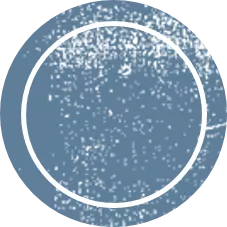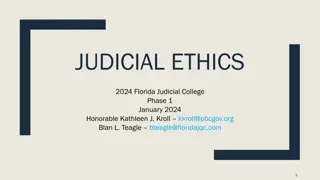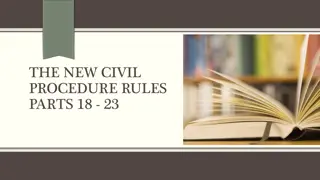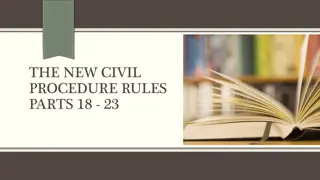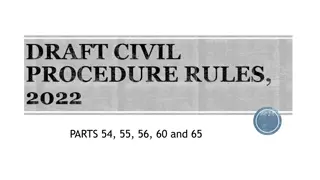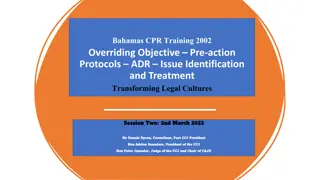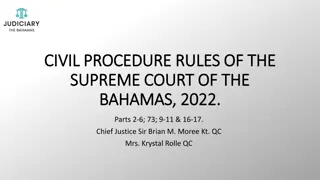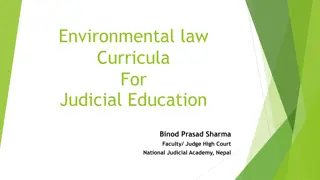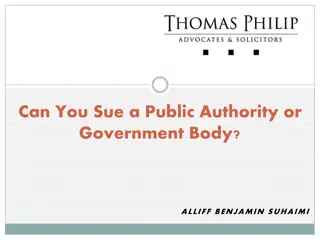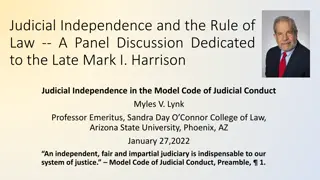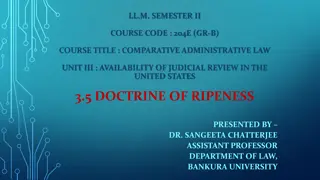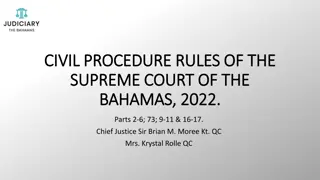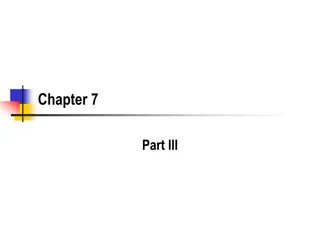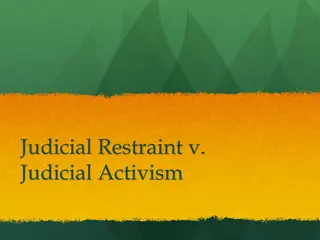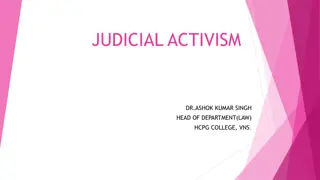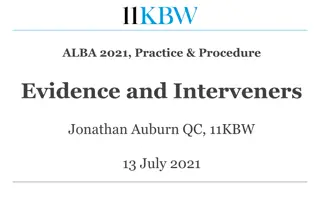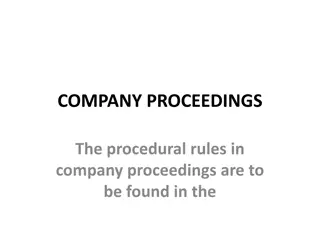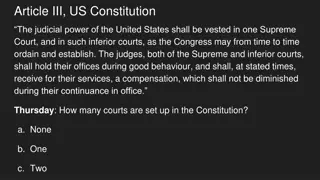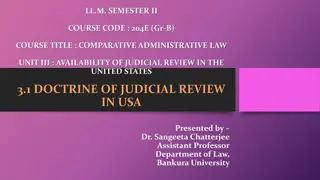Understanding Judicial Review in Civil Procedure Rules 2022
Judicial review in civil procedure involves the review of acts, decisions, and omissions of public authorities by superior courts to ensure legality, jurisdiction, and fairness of the decision-making process. Key aspects include the types of relief available, such as certiorari, prohibition, mandamus, declarations, injunctions, and damages claims. The process allows for challenging decisions not on their merits but on procedural grounds. (489 characters)
Download Presentation

Please find below an Image/Link to download the presentation.
The content on the website is provided AS IS for your information and personal use only. It may not be sold, licensed, or shared on other websites without obtaining consent from the author. Download presentation by click this link. If you encounter any issues during the download, it is possible that the publisher has removed the file from their server.
E N D
Presentation Transcript
DRAFT CIVIL PROCEDURE RULES, 2022 PARTS 54, 55, 56, 60 and 65
CPR 54 Judicial Review CPR 55 Application for Writ of Habeas Corpus CPR 56 Applications by the Attorney General CPR 60 Arbitration Proceedings CPR 65 Proceedings by and Against the Crown
Judicial Review Part 54 Fairly identical to the existing Order 53. Differences are cosmetic and reflects the changes in nomenclature.
This power of judicial review may be defined as the jurisdiction of the superior courts to review the acts, decisions and omissions of public authorities in order to establish whether they have exceeded or abused their powers. Judicial review is concerned, not with the merits of the decision but with the decision-making process itself i.e. with the legality of the decision, with the jurisdiction of the decision-maker and the fairness of the decision making process rather than whether the decision was correct. (Lord Hoffman in Kemper Reinsurance Co. v Minister of Finance [1998] 3 WLR 630 at 638; see also Lord Clyde in Reid v Secretary of State for Scotland [1999] 2 WLR 28 at 54.)
Nature of the relief available The order of certiorari; The order of prohibition; The order of mandamus; An application for a declaration or injunction; and Claims for damages.
An order of certiorari brings up into the Supreme Court the decision of an inferior court, tribunal or public authority for review so that the court can determine whether the decision should be quashed. (Part 54.1) The order of prohibition is an order issuing out of the Supreme Court and directed at an inferior court, tribunal or public authority which forbids that court, tribunal or public authority to act in excess of its jurisdiction or contrary to law. (Part 54.1) The order of mandamus is, in form, a command from the Supreme Court directing any person, inferior court or tribunal or public authority to carry out his or its duty according to law. (Part 54.1) An application for a declaration or injunction may be made by way of an application for judicial review. (Part 54.1) Claims for damages. On an application for judicial review, the court has power to award damages to the applicant, provided (1) the applicant has included in the statement in support of the application for leave, a claim for damages, and (2) the court is satisfied that, if the claim had been made in an action begun by the applicant he could have been awarded damages. Part 54.7(1)
Restrictions on the availability of judicial review There are a number of restrictions on the availability of judicial review. (a) It is only available in public law cases, i.e. against public bodies exercising public functions and inferior courts . (b) Usually, it may only be used as the remedy of last resort. (c) The applicant must have sufficient interest . (d) The applicant must act promptly.
JUDICIAL REVIEW PROCEDURE IN BRIEF Process begins by the filing of the prescribed Form A and the seeking of leave to apply for judicial review. Leave may be granted by a judge either without notice or on the papers. If leave is granted the applicant formally applies for Judicial Review. Following some form of case management the application is heard by the judge.
Part 54.3(4) Order 53, rule 3(4) (4) Where the application for leave is refused by the judge, or is granted on terms, the applicant may renew it by applying (a) in any criminal cause or matter, to the Court of Appeal; (b) in any other case, to a single judge sitting in open Court: Provided that no application for leave may be renewed in any non-criminal cause or matter in which the judge has refused leave under paragraph (3) after a hearing. (4) Where the application for leave in any criminal cause or matter is refused by the judge, or is granted on terms, the applicant may renew it by applying to the Court of Appeal.
Part 54.3 reflects a slight change from the counterpart Order 53 rule 3. Order 53 r 3(4)(b) is excluded from the new draft. Rule 3(4)(b) had provided for renewal in any case other than criminal cause, to a single judge sitting in open Court: Provided that no application for leave may be renewed in any non-criminal cause or matter in which the judge has refused leave under paragraph (3) after a hearing. The result is that there is no renewal in a non-criminal cause or matter.
Part 54.3(5) Part 54.3(5) omits the reference to Form B in the schedule. (5) In order to renew his application for leave the applicant shall, within 10 days of being served with notice of the judge s refusal, file in the Registry notice of his intention in Form [ ] in the Schedule to this Part.
Form B (rule 54.3(5)) Notice of renewal of application for leave to apply for judicial review THE BAHAMAS IN THE SUPREME COURT Name, address and description of applicant............................. The applicant intends to renew his application for leave to apply for Judicial Review........................................................... Signed......................................... Date................................. Received in the Registry of the Supreme Court.
Part 54.3(6) Rule 3(6) includes a proviso which is not contained in the Order 53 r 3(6). [in keeping with the usual rule on amendments] (6) The Court hearing an application for leave may allow the applicant s statement to be amended, whether by specifying different or additional grounds of relief or otherwise, on such terms, if any, as it thinks fit provided that if the applicant shall fail to amend his statement within the time specified by the order of the court then such order shall cease to have effect unless the court orders otherwise.
CPR 54.5 54.5 Mode of applying for judicial review (1) In any criminal cause or matter, where leave has been granted to make an application for judicial review, the application shall be made to a judge by an originating application. (2) In any other such cause or matter, the application shall be made by an originating application to a judge sitting in open Court, unless the Court directs that it shall be made to a judge in Chambers.
Part 54.5(3) and (4) Order 53 rule 5(3) and (4) (3) The originating application shall be served on all persons directly affected and where it relates to any proceedings in or before a magistrates court or tribunal and the object of the application is either to compel the magistrates court or tribunal or an officer of the magistrates court or tribunal to do any act in relation to the proceedings or to quash them or any order made therein, the application notice shall also be served on the Clerk or Registrar of the magistrates court or tribunal and, where any objection to the conduct of the magistrate or tribunal is to be made, on the magistrate or the president of the tribunal. (3) The notice of motion or summons shall be served on all persons directly affected and where it relates to any proceedings in or before a magistrates court or tribunal and the object of the application is either to compel the magistrates court or tribunal or an officer of the magistrates court or tribunal to do any act in relation to the proceedings or to quash them or any order made therein, the notice or summons shall also be served on the Clerk or Registrar of the magistrates court or tribunal and, where any objection to the conduct of the magistrate or tribunal is to be made, on the magistrate or the president of the tribunal. (4) Unless the Court granting leave has otherwise directed, there must be at least 10 clear days between the service of the application notice and the hearing. (4) Unless the Court granting leave has otherwise directed, there must be at least 10 clear days between the service of the notice of motion or summons and the hearing.
Part 54.5(5) Suggestion: Part 54.5(5) could include a provision for the leave to lapse if not pursued within 14 days, in keeping with the overriding objective and the new proviso to Part 54.3(6) (5) A motion must be entered for hearing within 14 days after the grant of leave.
Part 54.8 Order 53 rule 8 8(1) Unless the Court otherwise directs, any interlocutory application in proceedings on an application for judicial review may be made to a judge in chambers, notwithstanding that the application for judicial review is to be heard by a judge in open court. 8. (1) Unless the Court otherwise directs, any interlocutory application in proceedings on an application for judicial review may be made to a judge or the Registrar, notwithstanding that the application for judicial review has been made by motion and is to be heard in open court. (2) In this paragraph interlocutory application includes an application for an order under Order 24 or 26 or Order 38, rule 2(3) or for an order dismissing the proceedings by consent of the parties. (2) In this paragraph interlocutory application includes an application for an order discontinuing the application or for cross-examination of the maker of an affidavit. (3) In relation to an order made by the Registrar pursuant to paragraph (1), Order 58, rule 1 shall, where the application for judicial review is to be heard in open court, have effect as if a reference to the Court were substituted for the reference to a judge in chambers. (3) This rule is without prejudice to any statutory provision or rule of law restricting the making of an order against the Crown. (4) This rule is without prejudice to any statutory provision or rule of law restricting the making of an order against the Crown.
Part 54.9(1) Order 53 rule 9(1) 9. (1) On the hearing of any application under rule 54.5, any person who desires to be heard in opposition to the application, and appears to the Court to be a proper person to be heard, shall be heard, notwithstanding that he has not been served with an application notice. 9. (1) On the hearing of any motion or summons under rule 5, any person who desires to be heard in opposition to the motion or summons, and appears to the Court to be a proper person to be heard, shall be heard, notwithstanding that he has not been served with notice of the motion or the summons. (2) Where the relief sought is or includes an order of certiorari to remove any proceedings for the purpose of quashing them, the applicant may not question the validity of any order, warrant, commitment, conviction, inquisition or record unless before the hearing of the application he has filed in the Registry a copy thereof verified by affidavit accounting for his failure to do so to the satisfaction of the Court hearing the application notice. (2) Where the relief sought is or includes an order of certiorari to remove any proceedings for the purpose of quashing them, the applicant may not question the validity of any order, warrant, commitment, conviction, inquisition or record unless before the hearing of the motion or summons he has lodged in the Registry a copy thereof verified by affidavit of accounts for his failure to do so to the satisfaction of the Court hearing the motion or summons.
Habeas Corpus Part 55 Fairly identical to the existing Order 54. Differences are cosmetic and reflects the changes in nomenclature.
Habeas Corpus relief is available to anyone who alleges being unlawfully detained at the hands of the state. It sounds as a command to the detainer to deliver the body of the person detained and for a justification of that detention. This relief is widely used in relation to persons in the custody of the police, prison and immigration authorities. It is also, historically, the means for a challenge to extradition proceedings.
Application for Habeas Corpus Habeas corpus relief is available to anyone who alleges being unlawful detention at the hands of the state. It sounds as a command to the detain to deliver the body of the person detained and for a justification of that detention.
HABEAS CORPUS PROCEDURE IN BRIEF Applicant makes without notice application for a writ of habeas corpus to issue. At the hearing the judge may order: (1) the issuance of the writ of habeas corpus (Part 55.2) (2) an inter partes application, by the filing of an originating application (Part 55.2) (3) the release of the applicant (Part 55.4). Where writ of habeas corpus is ordered to issue, directions and the date on which the writ is returnable are given (Part 55.5). The return to a writ of habeas corpus must be indorsed on or annexed to the writ and must state all the causes of the detainer of the person restrained. The writ is heard by the judge (Part 55.8).
Part 55.1 Application for writ of habeas corpus ad subjiciendum Query why the use of the words otherwise than in Court which could only mean chambers. The equivalent provision in Barbados says in chambers. (1) An application for a writ of habeas corpus ad subjiciendum must be made to a judge in court except that in cases where the application is made on behalf of an infant, it must be made in the first instance to a judge otherwise than in court.
CPR 55.2 As we are moving away from the Latin ex parte embracing the plain language it is likely the term without notice should be substituted. 55.2 Power of court to whom ex parte application made
Power of court to whom ex parte application made Part 55.2(1) Order 54 rule 2(1) 2. (1) The judge to whom an application under rule 1 is made ex parte may make an order forthwith for the writ to issue, or may (a) where the application is made to a judge otherwise than in court, direct that an originating summons for the writ be issued, or that an application therefor be made by originating motion to a judge in court; (b) where the application is made to a judge in court, adjourn the application so that notice thereof may be given. 2. (1) The judge to whom an application under rule 1 is made without notice may make an order forthwith for the writ to issue, or may (a) where the application is made to a judge otherwise than in court, direct that an originating application applying for the writ be issued or that an application therefor be made orally to a judge in court; (b) where the application is made to a judge in court, adjourn the application so that notice thereof may be given.
Applications by the Attorney-General
Part 56 Part 56 is titled Applications by the Attorney-General . It is extremely misleading as it relates specifically to one type of application, an application to the Supreme Court by the Attorney-General under section 29 of the Supreme Court Act, 1996.
Section 29 of the Supreme Court Act 29. (1) If, on an application made by the Attorney General under this section, the Court is satisfied that any person has habitually and persistently and without any reasonable ground instituted vexatious legal proceedings whether in the Court or in any inferior court and whether against the same person or against different persons, the Court may, after hearing that person or giving him an opportunity to be heard, order that no legal proceedings shall, without leave of the Court or a judge, be instituted by him in any court and that any legal proceedings instituted by him before the making of the order shall not be continued by him without such leave, and such leave shall not be given unless the Court or judge is satisfied that the proceedings are not an abuse of the process of the Court and that there is a prima facie ground for the proceedings. (2) If the person against whom an order is sought under this section is unable on account of poverty to retain a counsel and attorney, the Court shall assign a counsel and attorney to him. (3) A copy of an order made under this section shall be published in the Gazette.
56.1 Attorney-General application (1) Every application to the Supreme Court by the Attorney- General under section 29 of the Supreme Court Act, 1996 shall be heard and determined by a judge. (2) The application must be made by an originating application, notice of which, together with an affidavit in support, shall be filed in the Registry and served on the person against whom the order is sought.
Attorney-General of the Commonwealth of the Bahamas v. Bowleg [1997] BHS J. No. 35 Only reported case concerning the operation for Section 29, heard in the absence of any specific rules. Relates to the now famous Harry Alphonso Bowleg. This was a decision of Moree J(Ag), (as he then was). Application brought by the Attorney-General by Originating Notice of Motion.
In that Affidavit Mrs. Smith stated that Mr. Bowleg had commenced over 26 actions in the Courts of the Bahamas. In fact, during his submissions Mr. Bowleg proudly declared that he had commenced approximately 50 actions in this Court and the Magistrate's Court. His appetite for litigation appears to be insatiable. During her submissions Counsel for The Attorney General reviewed most of the cases mentioned in the Affidavit of Mrs. Smith to support her contention that Mr. Bowleg was not successful in any of those actions. She also identified certain Appeals filed by Mr. Bowleg and further submitted that the Appeals which had been heard were all dismissed. To support this contention Mrs. Smith filed a second Affidavit on the 1st July, 1997 setting out particulars with regard to certain of those Appeals. Attorney-General v. Bowleg, [1997] BHS J. No. 35, para [6]
Some suggestions: (1) The rule could have required the Attorney General to chronicle the activities of the person the subject of the application as the AG did in the Bowleg case. (2) The rule could perhaps regulate the time within which a response would be required from the subject of the application. (3) There could also be a provision affording a specified period between the notice of the proceedings and the hearing. (4) As Section 29 affords the person against whom the Order is sought to be appointed Counsel, the rule could perhaps provide a mechanism for the Court or the Registrar to be notified of this need in advance the hearing.
Proceedings by and against the Crown
CROWN PROCEEDINGS Part 65 Fairly identical to the existing Order 69.
CPR 65.5(1) Part 65.5(1) Order 69 rule 5(1) 5(1) No application against the Crown shall be made under Part 15 for summary judgment or for specific performance in any proceedings against the Crown nor shall the Crown apply for summary judgment under Part 15 in any proceedings by counterclaim or in third party proceedings. 5. (1) No application against the Crown shall be made under Order 14, rule 1, or Order 75, rule 1, in any proceedings against the Crown nor under Order 14, rule 5, in any proceedings by the Crown.
65.5 (2) seems to be permitting the Crown counsel to be permitted to swear affidavits in actions where they are appearing, contrary to the established practice direction. 5(2) Where an application is made by the Crown under Part 15 for summary judgment or specific performance, the affidavit required in support of the application must be made by (a) the attorney acting for the Crown; or (b) an officer duly authorised by the attorney so acting or by the department concerned, and the affidavit shall be sufficient if it states that in the deponent s belief the applicant is entitled to the relief claimed and there is no defence to the claim or part of a claim with a real prospect of success to which the application relates at all or only except as to the amount of any damages claimed.
CPR 65.8 65.8 Interpleader: application for order against crown No order shall be made against the Crown under Part 49 (interpleader), except upon an application by summons served not less than 7 days before the return day. The reference to a summons should likely be to an interlocutory application.
PART 60 The Draft CPR Rules, as do the existing rules, provide a mechanism to facilitate Arbitration proceedings in The Bahamas and those connected to The Bahamas. The existing rules in the RSC predate the current Arbitration Act 2009 and The Arbitration (Foreign Arbitral Awards) Act 2009. The update is therefore necessary. Similar text was contained in the 2013 Draft CPR.
Part 60 is divided into 3 Sections: I - Arbitration Act 2009 II - Enforcement of an arbitration award to which section 6 of the Reciprocal Enforcement of Judgments Act III - The Arbitration (Foreign Arbitral Awards)Act 2009 (enforcement pursuant to The New York Convention on the recognition and enforcement of foreign arbitral awards adopted by the United Nations Conference on International Commercial Arbitration on 10th June, 1958)
Part 60.2 outlines a number of applications which must be pursued under the Arbitration Act 2009 by Fixed Date Claim Form. The rule also provides that the Fixed Date Claim Form is returnable before a judge in chambers.
(i) section 88: application for leave to enforce award (a) section 12: to extend the time for beginning arbitral proceedings; (j) section 89: challenging the award: substantive jurisdiction; (b) section 21: in relation to the disclosure or prohibition of disclosure of confidential information; (k) section 90: challenging the award: serious irregularity; (c) section 53: enforcement of peremptory order made by tribunal; (l) section 91: appeal on point of law; (d) section 55: court powers exercisable in support of arbitral proceedings (m) section 98: powers of court in relation to service of documents; (e) section 56: determination of preliminary point of law; (n) section 100: powers of court to extend time limits relating to arbitral proceedings; or (f) section72: extension of time for making award; (o) under any other provision of the Arbitration Act 2009, (g) section 85: in relation to costs of the arbitration; (h) section 86: questions in relation to fees and expenses of arbitrators;
Item (o) undermines the need to have listed all of the application in items (a) (n), since it provides that every application possible under the AA2009 is to be pursued in the same manner as the previous 14 types of applications.
The following applications shall be served on the arbitrator: (b) section 21: in relation to the disclosure or prohibition of disclosure of confidential information; (d) section 55: court powers exercisable in support of arbitral proceedings (e) section 56: determination of preliminary point of law; (f) section72: extension of time for making award; (g) section 85: in relation to costs of the arbitration; (h) section 86: questions in relation to fees and expenses of arbitrators; (j) section 89: challenging the award: substantive jurisdiction; (k) section 90: challenging the award: serious irregularity; (l) section 91: appeal on point of law; (n) section 100: powers of court to extend time limits relating to arbitral proceedings.
Part 60.1(4) provides for an applicant under section 88 (application for leave to enforce award) to apply for leave and subject to the court granting leave, apply for an order or orders in relation to the enforcement of the award at the same time.
Part 60.1(5) and (6) sets out the requirement of the Fixed Date Statement of Claim (5) An applicant who is additionally applying for an order for enforcement under paragraph (4) of this rule shall include in the fixed date statement of claim and in his affidavit all such particulars and evidence as may be necessary in relation to such order or orders for enforcement for which he is applying and the court may, on the hearing of such application for leave, make such order in relation to enforcement as it thinks fit. (6) In the case of every application other than an application under section 88, the statement of claim must state in general terms the grounds of the application and, where the application is founded on evidence by affidavit, a copy of every affidavit intended to be used must be served with the statement of claim.
Part 60.1(7) provides that the Chief Justice may from time to time direct which applications under the Arbitration Act 2009 shall or may be heard by the Registrar. This power seems undermined by the earlier provision (60.1(2)) which provides for the matter to be returnable before a judge in chambers.

 undefined
undefined


